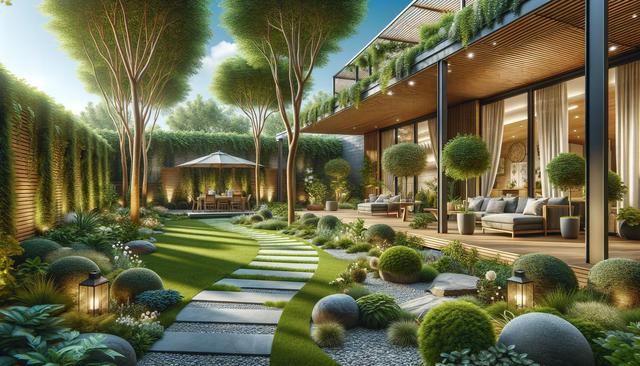Designing with Purpose: Understand Your Space
Before diving into any landscaping project, it’s crucial to assess the size, shape, and features of your backyard. Understanding your space helps you make informed decisions about layout, plant selection, and functional areas. Start by identifying the primary purpose of your backyard — is it for entertaining, relaxing, gardening, or family activities? Once you have a clear objective, you can begin sketching a layout that supports your goals.
Consider breaking your backyard into zones to enhance functionality. For example:
- A dining or BBQ area with durable patio furniture and a grill station
- A play zone for children featuring soft grass or a sandbox
- A quiet corner with a bench and shade trees for reading or meditation
Natural elements like trees, slopes, and existing structures should also be factored into your design. Working with — rather than against — these features can create a more harmonious and low-maintenance landscape.
Adding Greenery: Plants that Enhance Aesthetics and Ecology
Plants bring life, color, and texture to any backyard. When selecting greenery, choose a mix of perennials, shrubs, and ground covers that thrive in your local climate. Incorporating native plants can reduce water usage and attract pollinators like bees and butterflies, contributing to a healthier ecosystem.
Layering plants by height and bloom time creates visual interest throughout the year. Here are some planting suggestions:
- Low-maintenance grasses or groundcovers for edging pathways
- Mid-height shrubs to define borders or provide privacy
- Vertical elements such as trellises with climbing vines to add dimension
Don’t forget to include some evergreen varieties for year-round greenery, and mix in flowering plants for seasonal color. Container gardens are also great options for patios or smaller spaces.
Hardscaping Elements: Defining Structure and Function
Hardscaping refers to the non-living elements of landscaping, such as walkways, patios, retaining walls, and decorative stones. These features provide structure and improve usability, especially in areas with heavy foot traffic or uneven terrain.
Popular hardscaping materials include:
- Natural stone for a rustic, organic look
- Pavers for clean, modern lines
- Gravel or mulch for low-cost, permeable surfaces
Pathways help guide movement through your yard, while patios offer a solid foundation for outdoor furniture. Adding a fire pit or water feature can create a focal point and extend the usability of your yard into cooler evenings.
Lighting and Decor: Enhancing Ambiance and Safety
Outdoor lighting plays a dual role in backyard landscaping — it improves safety and sets the mood. Well-placed lights can highlight key features, illuminate pathways, and make your space more inviting after sunset. Solar-powered options or low-voltage LED systems are energy-efficient and easy to install.
Some lighting ideas include:
- String lights for a whimsical effect in seating areas
- Path lights along walkways and driveways
- Spotlights to highlight trees, sculptures, or architectural elements
In addition to lighting, outdoor decor items such as garden sculptures, wind chimes, or bird baths can personalize your space. Choose pieces that complement your landscape’s overall style, whether it’s rustic, modern, or eclectic.
Sustainable Landscaping: Smart Choices for Long-Term Benefits
Eco-friendly landscaping practices not only reduce environmental impact but also save time and money in the long run. Start by selecting drought-resistant plants and installing a drip irrigation system to minimize water waste. Using mulch around plants helps retain moisture and suppress weeds.
Other sustainable practices include:
- Composting kitchen and yard waste for natural fertilizer
- Installing rain barrels to collect water for irrigation
- Choosing permeable materials for walkways to reduce runoff
Incorporating edible plants like herbs, vegetables, or fruit trees adds functionality to your yard while promoting sustainable living. Even small gardens can yield fresh produce and reduce grocery trips.
Conclusion: Bringing Your Backyard Vision to Life
Redesigning your backyard can be a rewarding endeavor, especially when you balance aesthetics with functionality and sustainability. Whether you’re starting from scratch or making gradual improvements, thoughtful planning and creative ideas will help you make the most of your outdoor space. From purposeful layouts and vibrant plantings to functional hardscapes and eco-conscious upgrades, there’s a wide range of possibilities to explore. With consistent care and attention, your backyard can become a comfortable and inviting extension of your home.







